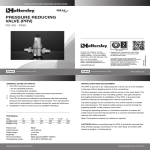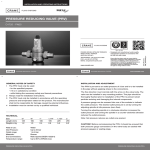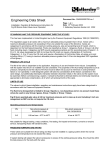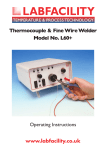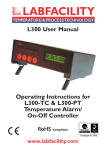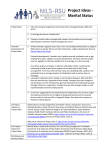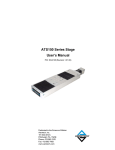Download Fig. 3047W Swing Check Valve
Transcript
Installation and Operating Instructions * Swing Check Valve Fig. 3047 ( / ” - 2”) Fig. 3047 W* ( / ” - 2”) 1 2 3 4 CE MARKING AND THE PRESSURE EQUIPMENT DIRECTIVE 97/23/EC This has been implemented in United Kingdom law by the Pressure Equipment Regulations 1999 (SI 1999/2001). The regulations apply to all valves with a maximum allowable pressure greater than 0.5 bar. Valves with a maximum allowable pressure not exceeding 0.5 bar are outside the scope of the Directive. Valves are categorised in accordance with the maximum working pressure, size and ascending level of hazard, which is dependent on the fluid being transported. Fluids are classified as Group 1, dangerous fluids or Group 2, all other fluids including steam. Categories are SEP (sound engineering practice) and for ascending levels of hazard, I, II, III or IV. All valves designated as SEP do not bear the CE mark nor require a Declaration of Conformity. Categories I, II, III or IV carry the CE mark and require a Declaration of Conformity (Note- all valves up to and including 25mm (1”) having a maximum allowable pressure greater than 0.5 bar are designated SEP regardless of fluid group.) PRODUCT LIFE CYCLE The life of the valve is dependent on its application, frequency of use and freedom from misuse. Compatibility with the system into which it is installed must be considered. The properties of the fluid being transported such as pressure, temperature and the nature of the fluid must be taken into account to minimise or avoid premature failure or non-operability. A well-designed system will take into consideration all the factors considered in the valve design, but additionally electrolytic interaction between dissimilar metals in the valve and the system must be examined. Before commissioning a system, it should be flushed to eliminate debris and chemically cleaned as appropriate to eliminate contamination, all of which will prolong the life of the valve. FAX: +44 (0)1744 26912 EMAIL: [email protected] EMAIL: [email protected] www.cranebsu.com LIMITS OF USE FM311 ISO 9001 • Designed and manufactured under quality management systems in accordance with BS EN ISO 9001-2008 Every effort has been made to ensure that the information contained in this publication is accurate at the time of publishing. Hattersley assumes no responsibility or liability for typographical errors or omissions or for any misinterpretation of the information within the publication and reserves the right to change without notice. H_SCV_0613 IOM_004B03047D799_v5 PO BOX 719, IPSWICH, IP1 9DU HOME SALES: +44 (0) 1744 458670 EXPORT SALES: +44 (0)1744 458671 TECHNICAL HELPLINE: 0845 604 1790 The valves to which these installation, operation and maintenance instructions apply have been categorised in accordance with the Pressure Equipment Directive. Installation and Operating Instructions These products are categorised for Group 1 Liquid, but are not necessarily suitable for all fluids in this group. Refer to Hattersley Technical Application Engineers for advice. Codes of practice, specifications and regulations should be referred to for specific guidance for valve selection on hazardous service. These valves may also be used on Group 2 Liquids, but on no account must they be used on any Group 1 or Group 2 gases. Fig 3047 and Fig 3047W Bronze check valves PN25 pressure ratings and in sizes up to and including 2 inch are categorised as SEP and do not require the CE mark OPERATING PRESSURES AND TEMPERATURES Fig No. PN Non-shock pressure at temperature range Non-shock pressure at max. temperature 3047 25 –10oC to 95oC 95 oC 3047W 25 o o –10 C to 85 C 85 oC Not suitable for fatigue loading, creep conditions, fire testing, fire hazard environment, corrosive or erosive service, transporting fluids with abrasive solids, high velocity gases that can cause shock waves. Valves must be provided with adequate support. Adjoining pipework must be supported to avoid the imposition of pipeline strains on the valve body. INSTALLATION Prior to installation, a check of the identification plate and body marking must be made to ensure that the correct valve is being installed. Valves are precision manufactured items and as such, should not be subjected to misuse such as careless handling, allowing dirt to enter the valve through the end ports and lack of cleaning both valve and system before operation. All special packaging material must be removed. Confirm that the pipe threading length is correct to avoid excessive penetration of the pipe into the valve, which would otherwise cause damage. Thread sealing compounds appropriate to the application should be used but excessive use should be avoided, since this increases thread interference and may cause overstressing of the body ends. Immediately prior to valve installation, the pipework to which the valve is to be fastened should be checked for cleanliness and freedom from debris. Ensure the threads are properly engaged and proceed to tighten the valve onto the pipe. The wrench must only be located on the valve end into which the pipe is being threaded to avoid distortion of the valve. PRESSURE/TEMPERATURE RATING These valves must be installed in a piping system where the normal pressure and temperature do not exceed the above ratings. If system testing will subject the valve to pressures in excess of the working pressure rating please check with Hattersley helpline. The maximum allowable pressure in valves as specified in the standards is for non-shock conditions. Water hammer and impact for example, should be avoided. If the limits of use specified in these instructions are exceeded or if the valve is used on applications for which it was not designed, a potential hazard could result. LAYOUT AND SITING The Fig. 3047 and Fig. 3047W check valve may be installed in horizontal pipework and vertical pipework if the flow is in an upwards direction. Swing Check valves having 6 diameters of straight lengths of pipe upstream and 3 diameters downstream are suitable for velocities up to 3 metres/second. If the valve is situated such that turbulence occurs, or is situated close to reciprocating pumps then the velocity should not exceed 2 metres/second. This valve must not be fitted in vertical pipelines with the flow downwards. In a horizontal pipeline the valve should be installed with the hexagon cap uppermost. The valve must be installed with the direction arrow on the body coincident with the direction of the flow in the pipeline. 02 Hattersley Swing Check Valve (SCV) OPERATION The Fig. 3047 and Fig. 3047W check valve are self-acting. MAINTENANCE The Fig. 3047 and 3047W check valve are almost maintenance free. After a prolonged period in service it may require the replacement of the resilient disk facing. The valve should be at zero pressure and ambient temperature prior to any inspection. 1. Unscrew and remove the cap and hinge pin plug. 2. Withdraw the hinge pin and remove the disk/hinge assembly through the top of the body. 3. Unscrew the resilient disk retaining nut and remove the old/damaged disk. 4. Inspect the disk for damage and remove any deposits or debris from the main metal disk and the sealing face in the body. 5. Fit the new resilient disk and retighten the retaining nut. 6. Lock the nut to the metal disk by deforming the mating threads using a centre punch and hammer. 7. Refit into the valve body, and tighten the cap and hinge pin plug, inspect for leakage. Hattersley Swing Check Valve (SCV) 03


